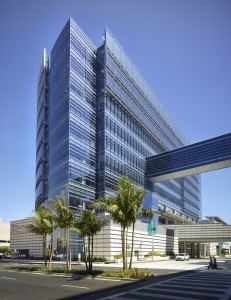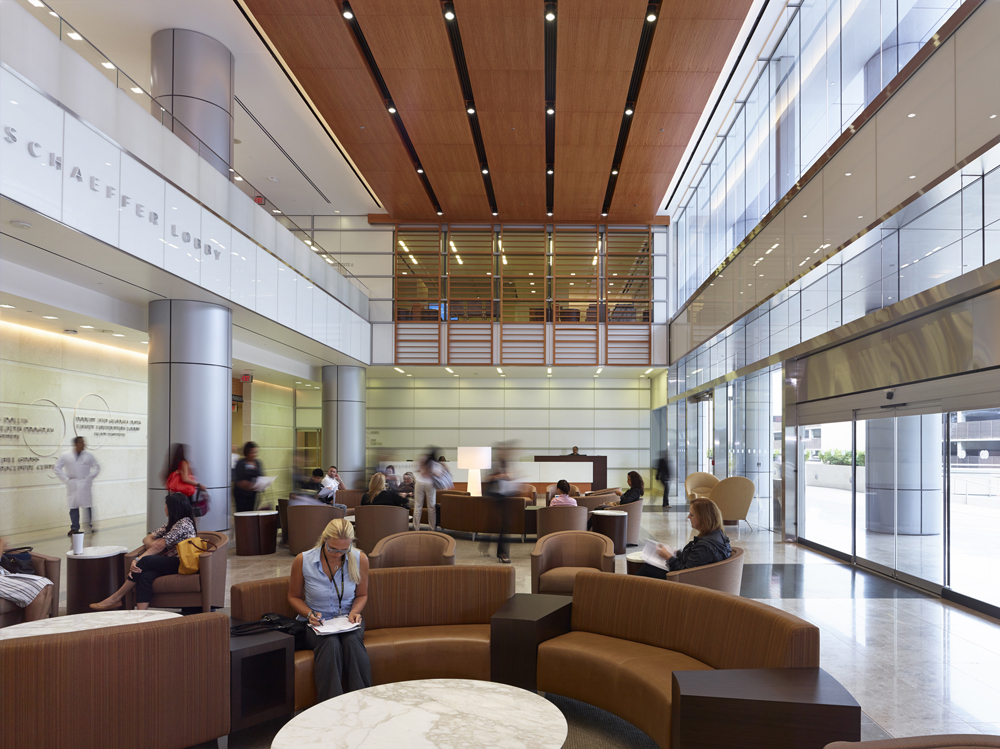LOS ANGELES, Calif. — The 11-story, 820,000-square-foot Cedars-Sinai Advanced Health Sciences Pavilion opened this summer in Los Angeles, Calif. HOK’s team of medical planners, architects and designers worked with Cedars-Sinai to design a building that brings together clinical, research, training and collaboration spaces. Envisioned as a tool to accelerate change, the pavilion integrates world-class patient care, medical research and teaching. With the proximity of translational labs to clinical settings, new research discoveries can transform patient care.
 “The Advanced Health Sciences Pavilion is the realization of Cedars-Sinai’s vision for 21st-century healthcare,” said Robert Cull, executive project director for the Cedars-Sinai Health System. “As the program evolved in complexity and scale during the planning process, the hospital’s commitment to creating a state-of-the-art environment that would support a new model of collaborative practice only strengthened. More importantly, we understood that bringing the researchers and clinicians into the same facility as the patients would speed advances in research to benefit all.”
“The Advanced Health Sciences Pavilion is the realization of Cedars-Sinai’s vision for 21st-century healthcare,” said Robert Cull, executive project director for the Cedars-Sinai Health System. “As the program evolved in complexity and scale during the planning process, the hospital’s commitment to creating a state-of-the-art environment that would support a new model of collaborative practice only strengthened. More importantly, we understood that bringing the researchers and clinicians into the same facility as the patients would speed advances in research to benefit all.”
The pavilion is clad in a shimmering, double-glass skin, with a broad, curved façade that wraps along San Vicente Boulevard, the major thoroughfare leading to the Cedars-Sinai campus.
“The image of the building, with its high-tech sensibility, sleek transparency and quality, well-crafted materials, speaks to the synergy of healthcare and science that is at its heart,” said Ernest Cirangle, AIA, LEED AP BD+C, HOK’s design director in Los Angeles.
The pavilion houses the Cedars-Sinai Heart Institute, neurosciences program, Regenerative Medicine Institute, translational research laboratories, an education center with advanced simulation labs and two floors of procedural space. Outpatient facilities include waiting rooms, clinics, imaging suites and a pharmacy. The building connects to the existing medical center campus at the plaza level off the main lobby and with the 180-foot-long, Sue and Bill Gross Skywalk bridge at the fifth level.
Designed to achieve LEED Gold, the building features efficient mechanical systems, a photovoltaic system and high-performance façades that to respond to environmental conditions. The exterior skin has high-performance glass and perforated metal panels that reduce heat gain and glare while providing a comfortable interior environment. On the east and west façades, a double-skin of glazing and sun screens of vertical glass fins mitigate solar gain and glare from the low-angled light. On the southern exposure, the recessed windows and light shelves compose a restrained façade. On the north face, at the building prow, floor-to-ceiling windows offer stunning views of the Hollywood Hills and provide natural light for the boardroom and other business functions.
At lower levels, the building conveys a civic sensibility with a natural limestone base that creates a plinth for the glass structure above. The limestone forms an entrance canopy that leads to the ground floor lobby and simulation lab, which are fronted with large windows that provide light and views to the outside.
On the top two floors, which are dedicated to research, a connecting stair opens to a gathering space and encourages collaboration among physicians, researchers and educators. Located adjacent to the translational research laboratories, this grand “living room” attracts researchers seeking space for quiet concentration or casual meetings in a break area.
HOK designed the outpatient environment to help patients feel comfortable. The space is light-filled and easy to navigate. The single waiting room in the double-height main lobby at the second floor plaza level provides a sense of orientation. Many of the outpatient services — including intake, imaging, pharmacy and a café — are just steps away from this lobby.
Materials and details throughout the public spaces promote the quality and care that characterize the Cedars-Sinai brand. From the Jerusalem limestone in the main lobby, to the calming, spa-like feel in the sixth-floor neuroscience waiting area, to the ample seating and comfortable lighting at every level, the design focuses on the well-being of each patient.
The pavilion recently won an award from American Institute of Architects California Council. In naming the project to its 2013 Design Awards list, the jury cited the facility for its groundbreaking approach in the creation of a structure to house both clinical care and research laboratories.
Other HOK projects in Los Angeles include the Anaheim Regional Transportation Intermodal Center, the Veterans Affairs Inpatient-Outpatient Mental Health Facility and Community Living Center in Long Beach and the Scripps Memorial Hospital Prebys Cardiovascular Institute in La Jolla.





